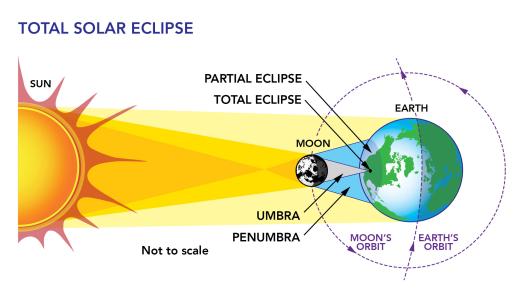A solar eclipse occurs when the Moon passes between Earth and the Sun, thereby obscuring Earth's view of the Sun, totally or partially. Such an alignment coincides with a new moon, indicating the Moon is closest to the plane of the Earth's orbit. In a total eclipse, the disk of the Sun is fully obscured by the Moon. In partial and annular eclipses, only part of the Sun is obscured.
>> Read More >>
Just one moment,
loading Earth as a System...
Featured Interactives
-
-
-
-
-
-
-
Grade Level: 6-8, 9-12
In this StoryMap lesson students will learn how living with a star can teach us about our universe.
Grade Level: 6-8, 9-12
In this interactive, students will explore safe methods for viewing the Sun at home or in the classroom, including using solar eclipse glasses and a pinhole projector. The interactive includes a video that explains how the projector works and how to build one.
Grade Level: 6-8
In this activity students will make observations about the objects, size, distance, and motion of the Sun, Earth, and Moon during a solar eclipse and manipulate slides to show the relationships.
Grade Level: 6-8, 9-12
This interactive takes students through the basic mechanics of a solar eclipse, using a NASA Space Place Handout, including an optional eclipse art activity.
Grade Level: 6-8
In this activity students will calculate the ratio of the size of the sun to the moon and the distance of the sun and moon from Earth to determine the type of solar eclipse possible.
Grade Level: 6-8, 9-12
In this interactive, students will learn the basics of space weather by engaging in a short interactive which introduces key terms: space weather, sunspot, solar flare, coronal mass ejection, and solar wind. Students will be able to identify the causes and hazards of space weather.
Grade Level: 6-8, 9-12
This interactive guides students through exploring how stars create the elements that make up the universe and life itself. Students will be able to identify the key elements in their bodies that were created from exploding stars.
Previous
Next
Grade Level: 6-8,
9-12
In this StoryMap lesson students will learn how living with a star can teach us about our universe.
Grade Level: 6-8,
9-12
In this interactive, students will explore safe methods for viewing the Sun at home or in the classroom, including using solar eclipse glasses and a pinhole projector. The interactive includes a video that explains how the projector works and how to build one.
Grade Level: 6-8
In this activity students will make observations about the objects, size, distance, and motion of the Sun, Earth, and Moon during a solar eclipse and manipulate slides to show the relationships.
Grade Level: 6-8,
9-12
This interactive takes students through the basic mechanics of a solar eclipse, using a NASA Space Place Handout, including an optional eclipse art activity.
Grade Level: 6-8
In this activity students will calculate the ratio of the size of the sun to the moon and the distance of the sun and moon from Earth to determine the type of solar eclipse possible.
Grade Level: 6-8,
9-12
In this interactive, students will learn the basics of space weather by engaging in a short interactive which introduces key terms: space weather, sunspot, solar flare, coronal mass ejection, and solar wind. Students will be able to identify the causes and hazards of space weather.
Grade Level: 6-8,
9-12
This interactive guides students through exploring how stars create the elements that make up the universe and life itself. Students will be able to identify the key elements in their bodies that were created from exploding stars.
Solar Eclipse landing page. Explore maps, graphs, data, and related education resources. These resources include lesson plans, mini lessons, activities, and datasets for teachers and students.















